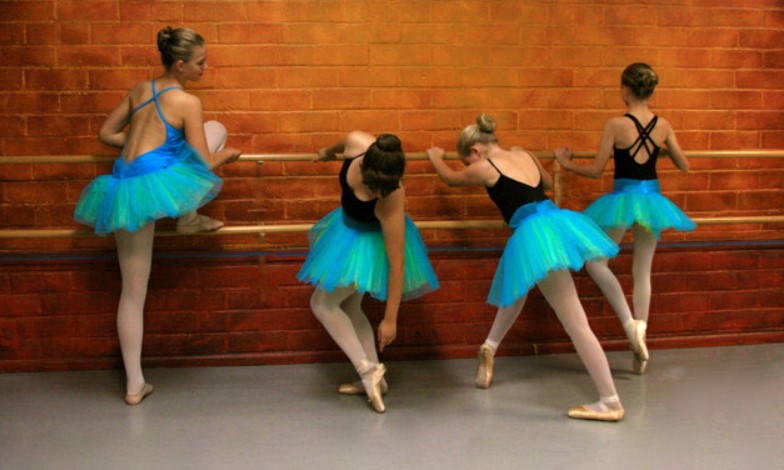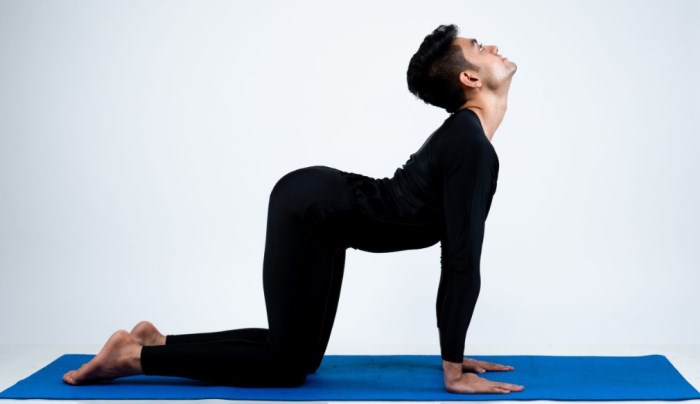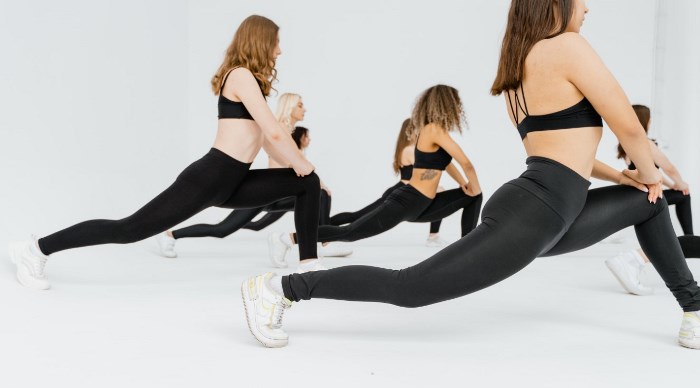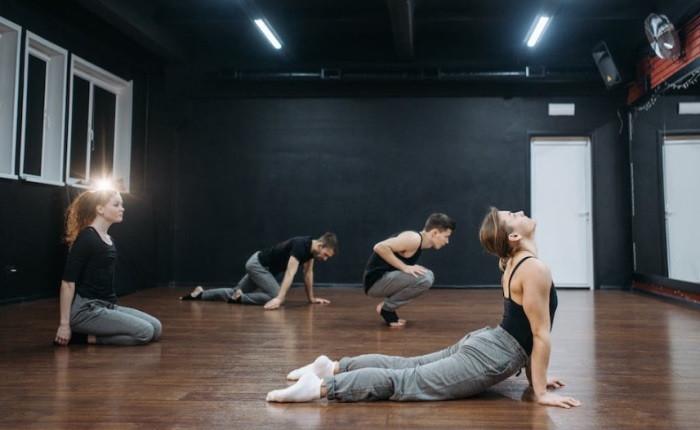Being flexible makes our daily tasks a lot easier. And dancers who always push their bodies to their limits need it even more.
Here are some stretches for dancers’ flexibility that can target the groups of muscles you have neglected or not known about yet.
You can start from the basics, give your muscles some time to adjust, and try the advanced moves for more efficiency!
Table of Contents
Best Stretches For Dancers’ Flexibility
There are various beginner flexibility stretches that you might want to try and incorporate into your practice.
If you are not confident about creating a routine of your own, these basic positions can help you target multiple sections of your body.
Upper Body Flexibility Stretches
Neck Stretch
Having some mobility is a good start for a new day in general.
- Stand straight with arms on your side and tilt your head towards the tip of your shoulder.
- Hold the position for 10 – 15 seconds and change the side.
Advanced version: Reach to the ear with the opposite arm from behind your head.
Shoulder & Arm Stretches
Next, we work on the joints of your shoulders and stretch the muscles of your arms.
- Hold an arm forward and place the other hand on the underside of the biceps. Press the arm across your chest and hold firmly for some tension behind your shoulder.
- You can also guide the stretched arm by linking your hands together.
- Another way is to raise an arm and fold it behind your head, trying to touch the place between your shoulder blades. Place your other hand on this elbow and apply pressure for a deeper stretch.
Shoulder Squeeze
After targeting the back of your shoulders, we can’t leave the front neglected.
- Put your hands together behind your back and straighten your posture, so your arms will be extended.
- Push your shoulders back and squeeze the muscles for good tension before holding the posture for a while.
Advanced version: Lower your chin to your chest for a deeper stretch.
Side Stretch
Side stretches target the core – an exceptionally important part of elongated postures in ballet.
- We usually start from a sitting position.
- Extend an arm and sling it over your head as you lean to the other side. Your ribs should feel the tension very clearly.
You’ll love: 7 Best Makeup For Dancers
Lower Body Flexibility Stretches
Quad Stretch
It works on ankles, calves, hamstrings, and quads at the same time for a steady foundation.
- From a standing position, lift your foot to your bottom as if you are doing butt kicks.
- Use the arm on the same side and hold your foot to feel the front muscle of your thigh stretch.
Calf & Ankle Stretches
These spots are extremely important for dancers, and we mustn’t overlook them.
- For a calf stretch, step forward like you are doing a lunge and keep your feet flat on the floor. You can use a wall if you need more support.
- Lean forward until your calf and your ankle are nicely stretched. You should maintain this posture for at least 30 seconds.
- To focus more on the ankles, lie down and hold a foot upwards. Point your toes forwards and flex your foot several times to get the ankle working.
- If you need to improve flexibility for spinning, slowly rotate your foot so your range of motion is smooth clockwise and counterclockwise.
Standing Hamstring Stretch
The affected zones for this stretch range from the calves, hamstrings, and glutes, to the lower back.
- Stand with your feet neither too close nor too far apart and put one foot forward.
- Bend forth like you are going to fold your body. Be sure you are not locking your knees and hold the position for 30 seconds.
Check more: 10 Best Leggings For Dancers
Back Flexibility Stretches For Dancers
Cat-Cow
The neck, the shoulders, and the back are all under the effect of cat-cow stretches.
- Get on all fours with your legs forming 90-degree angles with the floor and your arms straight.
- Cow position: Lower your stomach towards the ground and accentuate your back while not moving your shoulders and hips at all.
- Cat position: Let your back return to the straight state and slowly push your spine into an arch towards the ceiling.
Cobra
Cobra is one of the classic stretches to improve back flexibility for dancers. It is amazing for tension relief.
- Get on all fours and incline forwards by lifting your hips and lowering your body to the ground.
- Press your hips to the floor and keep your arms straight.
- Look forward and arch your back until your core and legs feel the tension.
Camel
Like the lumps on a camel’s back, the camel position gives your back more strength while helping your front stretch.
- Kneel with your posture straight and place both hands on the behind of your hips.
- Direct your chest towards the ceiling above and reach for your heels with your hands, one at a time. Your hips should push forth as you arch your back upwards for stretching.
- After holding this posture for 30 seconds, tilt your chin to your chest and flex the core to return to the normal position.
Scorpion
If you need spinal rotation, scorpion twists would be a nice addition.
- Lie down on your stomach with all limbs extended comfortably.
- Put your palms on the floor for support and lift a leg upward with the knee at a 90-degree angle. Move the leg towards the other side of your body.
- You should feel your hips, quads, and back tensed. Hold the position with your foot pointing to the floor.
Supine Twists
- Lie down on the floor with your arms spread into a T.
- Pull your legs up to 90 degrees and lower them to one side while not letting your body arch off the ground at all. This position should cause tension on the other side of your back.
- Hold your legs in the center again and repeat the movement for the other side.
Advanced version: Turn and face the opposite side of your knees or cross your legs.
Check now: 7 Best Ballet Foot Stretchers for Dancers’ Flexibility
Hip Flexibility Stretches For Dancers
Like how much attention we spend on the hips of the dancers, leg flexibility is important in performance as well.
Low Lunge
First, we target your quads, groin, and hip flexors.
- From a standing position, step forward and kneel for a normal lunge. Make sure your front knee is aligned with the same ankle, while your other leg lowers onto the floor.
- Instead of pulling your leg back like the standard lunge, hold the position for 30 seconds before switching to the other side.
Advanced version: Lean forward and lower your chest closer to the front knee.
Butterfly
This position is good for the glutes, hips, and thighs.
- Sit down on the floor with your back straightened. Bend your legs with your knees directed outside and your feet pressed together.
- Use your hands to hold onto your heels and slowly lean forward without lifting your knees.
Frog
Aside from strengthening muscles, opening your hips is necessary too. Nonetheless, frog stretches are fairly difficult for beginners.
- Get into an all-fours position and push your knees wider apart. The angle should be wider than your shoulders and your toes should point outside.
- Slowly lower your body with the inner thighs pressed to the floor and push your hips backward to your heels.
Advanced version: Lowering your forearms will deepen the stretch, but don’t push yourself too much!
Piriformis Stretch
There is a small bundle of muscles behind the glutes that connect your upper thigh with your lower spine.
As you can tell, it is extremely important for hip rotation and turning on feet.
- Lie down on the floor with your legs folded, knees towards the ceiling, and feet on the ground.
- Put your right ankle on your left knee like you are sitting cross-legged. Pull your left knee towards your chest while reaching for your left ankle from behind the thigh until your glute feels tensed.
Advanced version: Press on your right thighs using your right elbow.
Standing Forward Fold (or Seated Forward Fold)
- You can stand or sit to start this position, but make sure your back is straight and your knees are not locked.
- Bend forwards and reach for your toes while keeping your back and your legs in that perfectly straight line.
Dance Stretches For Splits
Split is one of the advanced techniques that every dancer wants to achieve.
Aside from other stretches, there are a few intensive movements that concentrate on certain spots and ensure a perfect slip.
Pigeon
Pigeon is a move from yoga focusing on your lower back, hips rotators, and hip flexors.
- Stand with your arms relaxed on your sides, feet, and hips in a straight line.
- Slowly bend forward and maintain a proper line for your spine.
- Use your right leg to lunge forth while inhaling and slowly kneel, your left heel should be lifted from the ground.
- Keep your right calf down on the outer side and exhale calmly. Your hips should be close to your right heel, your left heel should face the ceiling.
- With your palms on the floor in front of you or next to your shins (depending on how comfortable your body is), straighten your spine and puff your chest out.
- Try to look far forwards and breathe deeply as you hold the posture for 30 seconds.
- Once finished, exhale and pull your stretched leg back so you can be on all fours. Return to the bending position and stand up again with a deep inhale.
Advanced version: Lowered forearms and head if you want to make the most out of it.
Lizard
Lizard is another yoga position for hip flexors, quadriceps, and hamstrings.
- Start on all fours. Your biceps and forearms should form a 90-degree angle, with the forearm flat on the mat and the fingers pointing forwards. Your hips should be directly above your knees and your feet are aligned with your entire body.
- Pull your right leg upwards and forward until the foot is next to your right hand. There should be some tension in your left hip.
- Lower your left knee and put pressure on your hips. Don’t forget to keep your spine unbent and your eyes forward.
- Stretch your left leg further and prop on the ball of your foot. Breathe evenly while you hold the position.
Advanced version: Lower your body onto your forearms and press harder on the heel.
Standing Splits
Standing split is a simple but effective way to achieve the full split. Besides the quads and the hamstrings, it also enhances your sense of balance.
- From a standing posture, bend forward until your palms touch the ground. It’s very similar to a Downward Dog.
- Transfer your body weight onto your right foot and lift the other leg as high as possible.
- Pull your upper body closer to your leg by crawling on your hands.
- Keep going and enjoy the nice tension in your hips as your legs are in a fixed position.
Supported Splits
Supported split is another technique for you to eventually get into that dreamy split.
- Put a workout block in front of you.
- You can conveniently start from the lizard pose above. Shift your weight backward and sit up while gradually straightening your previously folded leg.
- Rely your weight on the support block and adjust your feet for a nice split.
Deep Stretches In Flexibility Exercise
We are not talking about advanced stretches for difficult routines. But the ones even beginners can do and deepen the effect inflicted upon their muscles.
Breathing
You might find it irrelevant because what does breathing have to do with stretches? Controlled and calculated breathing can help you sink further into stretches.
Breathing is especially important in dynamic stretches because it can assist your muscles when you flex and elongate your limbs.
When the postures become more familiar, the breathing will be natural. And you can do it without losing focus in your stretches.
Training & Tools
You won’t need tools and extra training as a beginner. Yet, when your body is too familiar with a stretching routine, it won’t benefit as much from these positions anymore.
Improving your strength and building support are the keys to difficult moves.
If you can invest in tools, elastic bands for arms or legs workout will motivate your muscles to exert more and stretch deeper.
Furthermore, getting a partner to help you during stretching is a great idea as well!
Tips To Boost Flexibility For Beginners
If you neglect certain parts of your body for too long, their mobility will decrease tremendously and eventually cause your body to be strained all the time.
For dancers, mobility is even more important, because it allows the joints to reach their full potential of motion ranges.
When restricted by muscles, tendons, or ligaments, people will find it hard to get basic tasks done, let alone intense training. A dancer with untrained flexibility is very vulnerable to injuries.
Take Time
Flexibility involves the training of your joints, thus it will take time. Don’t trust the ‘quick’ methods on the internet.
Rushing in this sort of training can backfire and hurt you instead.
Try to learn the strongest and weakest points of your body. Give them some time to adapt to the routines, and your dance moves can go a long way.
Warm-Up First
Stretches are a form of exercise and they can’t replace the warm-up. A short walk is the simplest form of cardio to wake your muscles up and increase your heart rate.
When your blood flow is in the right state, you can get a few stretches going without any hindrance.
Otherwise, attempting wide ranges of motion immediately will only get you injured more easily.
Choose The Best For You
Your body will work differently from others. If someone is more flexible than you, they can nail the routine in a few days, while you might need months.
Don’t put yourself on an unfair comparison and ignore the signals from your muscles.
Choose a routine that allows you to improve your weakness and enhance your advantages.
In dance stretches for beginners, the stretches shouldn’t last for longer than 15 seconds at first. You can prolong this duration gradually.
Do Stretches Before & After Class
Stretches are generally divided into two types: dynamic and static.
Dynamic stretches include arm swinging, and torso twisting. Shoulder rolling is some exercise that can activate your muscles and stir momentum, hence they are very suitable before class.
For the lower body, leg swings, hip circles, and lunges are enough to get your muscles working. Holding a position is not the priority here, for your target is blood circulation and a gentle warm-up.
On the opposite, we will have to hold our posture for a bit in static stretching.
Without constant movements, you can deepen the impact you are trying to inflict on your muscles and also cool down after a quick-paced dance practice. The duration for these stretches should be at least 30 seconds, and 60 – 90 seconds if you can hold it.
As a dancer, you might want to skip ballistic stretches. The bouncing motions will put your muscles in a repeated and speedy cycle of tension and relaxation, turning you subjectable to damage and injury.
Don’t Push Yourself Too Hard
When you start doing stretches, you might notice parts of your struggle while the rest is coping with the routine just fine.
However, you shouldn’t force your strained areas to stretch.
Instead, find the limit where your muscles have to work hard without feeling pain and stick to that limit.
Pain is an alarm that your body is not doing well, and you should never ignore it.
Set A Routine
If you want to be consistent and thorough with stretching, it’s advisable to create a routine so you won’t miss out on any area.
The most common method is working on the most troubled spots and giving them 30-second exercises for the entire week.
Stretching should be included in a dancer’s practice because it prepares the body for different sets of movements.
Doing stretching exercises from the top to the bottom (or the other way around) will avoid missing out on a group of muscles and putting it at risk of injury.
Set Time For Stretching
Like many other forms of practice, you shouldn’t go for long sessions right off the bat.
Four 10-minute stretch sessions per week with each position lasting for 15 – 20 seconds would be a decent start. Letting your muscles relax and recover will enhance the efficiency of the exercises.
Once your body adjusted to the stretches, you can prolong the duration of each move and the session overall, or the number of sessions you have each week.
Final Words
Stretches for dancers’ flexibility are an important part of any practice, no matter what dance style you are pursuing.
Doing stretches regularly also helps you relieve stress and maintain a positive state of mind.
Remember that flexibility training takes more time than one or two days. So, be patient with your body and give it enough time to improve instead of forcing it to endure something beyond its capability.





